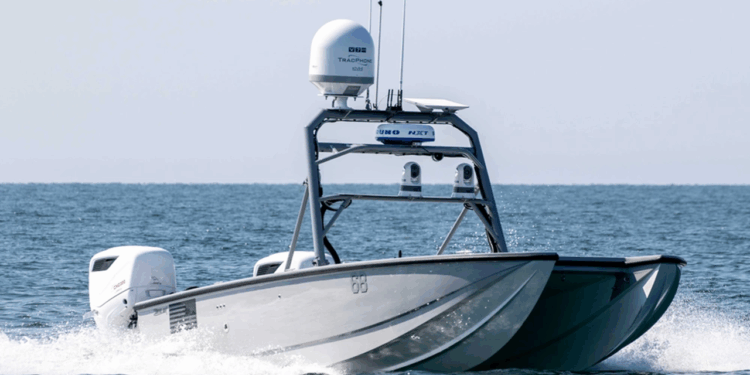The Royal Navy has experimented with naval drones for several years—and has recently developed the “Rattler,” an unmanned boat capable of remote operation from hundreds of miles away.
As the British Empire grew from the mid-1700s to the early 19th century, the Royal Navy was chronically understaffed, leading to creative and often unscrupulous efforts to increase its manpower. One such “recruitment” effort involved press-gangs—kidnapping men at random and dragging them aboard ship for military service.
As the Royal Navy faces a recruitment crisis once again, and can no longer resort to press-gangs, it is likely to instead employ uncrewed vessels to make up the shortfall.
The Royal Navy recently carried out a demonstration of five unmanned remotely-piloted boats that were able to swarm and escort the River-class offshore patrol vessel HMS Tyne (P281) as it was operating off the coast of Scotland. Even more impressively, during the 72-hour training sortie, the five uncrewed “Rattler” boats were controlled by operators more than 500 miles away.
“The demonstration saw the vessels work with P2000 HMS Biter of the Coastal Forces Squadron, a Merlin helicopter, HMS Tyne and HMS Stirling Castle in a proof of concept exercise,” the Royal Navy explained.
The autonomous Rattler boats, each 7.2 meters in length, engaged the two Royal Navy warships, which were serving as foreign vessels in the drills.
According to the UK’s senior service, this demonstration was the “culmination of months of trials,” involving careful coordination between the Disruptive Capabilities and Technology Office (DCTO) and the Fleet Experimentation Squadron (FXS).
The Rattler Boats Are Purpose-Built for the Royal Navy
The other noteworthy aspect of the Rattler boats is that the Royal Navy was able to procure a fleet of seven autonomous vessels, built around rigid inflatable boats (RIBs) fitted with autonomy packages, in just a matter of weeks.
The boats were developed to be fully uncrewed and able to “operate individually or as part of a swarm,” the Royal Navy added. Each can be “pre-programmed with mission profiles, navigational routes,” and then sent out as lone wolves or part of a “wolf pack.”
Moreover, the Rattlers were designed to carry out a variety of missions, including surveillance, reconnaissance, and payload delivery. They are small enough to be deployed by air, transportable via land, and can be launched from portable slipways.
The Rattler can be operated by a two-person team, with one person piloting the uncrewed drone and the other monitoring the various sensors and systems, while managing live data streams. According to the Royal Navy, the drones can be operated by “plug and play” software.
Although the boats were remotely controlled during the recent swarming operation of HMS Tyne, the developers believe that in the future, they will be able to operate without any direct human control.
“This is a really important moment for the Royal Navy as we progress towards a Hybrid Navy of crewed and uncrewed platforms,” explained Commander Michael Hutchinson of the Royal Navy.
The UK Is Experimenting with Other Naval Drones, Too
The recent trials of the Rattler boats followed a Royal Navy remote control test of its Experimental Vessel (XV) Excalibur, an “Extra Large Uncrewed Underwater Vehicle” (XLUUV), this past summer. Contact with Excalibur was maintained, even as it was submerged on the far side of the world. That demonstration was part of the AUKUS Pillar II effort, which focuses on the joint development of technology among the United Kingdom, the United States, and Australia.
The Royal Navy formally unveiled the 12-meter (39-foot) long unmanned vessel, which displaces 19 tonnes, earlier this year.
Before the Rattler was deployed for the swarm drills off the coast of Scotland, the unmanned boats were tested from the Royal Navy’s facilities in Portsmouth. They were operated in the “incredibly busy waters of the Solent and Portland.”
The Royal Navy will continue its broader push towards uncrewed and autonomous vessels, which are a key component of the future “Hybrid Navy.” It also highlights how such technology can be introduced quickly and potentially at scale.
“These USVs have been built and developed at pace, in a ground-breaking way, alongside a coalition of fantastic local companies this has been the most exciting project of my career,” added Commander Hutchinson, who is now the commanding officer of the newly formed Fleet Experimentation Squadron. “These platforms will be used alongside and in support of existing and future warships and as a capability in their own right. It is a technology that will continue to develop and it will fundamentally change the way we fight.”
About the Author: Peter Suciu
Peter Suciu has contributed over 3,200 published pieces to more than four dozen magazines and websites over a 30-year career in journalism. He regularly writes about military hardware, firearms history, cybersecurity, politics, and international affairs. Peter is also a contributing writer for Forbes and Clearance Jobs. He is based in Michigan. You can follow him on Twitter: @PeterSuciu. You can email the author: [email protected].
Image: Wikimedia Commons.


















